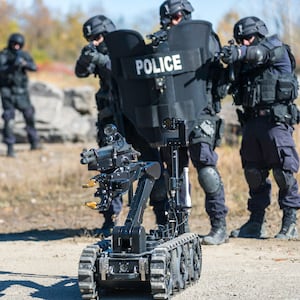As if the robot uprising wasn’t inevitable enough, scientists engineered a spider-like bot that can quickly scurry up walls using magnetic feet.
In a study published Dec. 14 in the journal Science Robotics, researchers at Korea Advanced Institute of Science and Technology designed the untethered robot, dubbed Magnetically Adhesive Robot for Versatile and Expeditious Locomotion (MARVEL), to be able to crawl around magnetic walls and ceilings—and even around a curved storage tank. The authors claim that the robot is quicker and more agile than its climbing counterparts.
Aside from being another weapon in the robot wars, the bot has the potential to greatly assist industrial workplaces without endangering the health and lives of human workers.

Sequential snapshots of MARVEL climbing on a storage tank.
Kim, Min Su and Hong, Seungwoo and Park, Hae-Won, Mechanical Engineering, Korea Advanced Institute of Science and Technology“[MARVEL] demonstrates the fastest vertical and inverted walking speed while its versatile locomotion ability enables the most number of gaits and locomotion tasks,” the authors wrote.
The robot weighs roughly 18 pounds and is about the size of a shoebox. It uses a unique foot design that incorporates electro-magnets and magnetic elastomers (a fancy term for a stretchy, rubber-like material). This allows it to confidently stick to metal surfaces while bandying about using motors and actuators to control its four legs.
In experiments, MARVEL clocked in at 0.7 meters (more than two feet) per second while walking on ceilings, and 0.5 meters (more than one and a half feet) per second while climbing vertically up walls. The robot could also navigate around small obstacles and even move over gaps in the surfaces.
The authors said that MARVEL can also lug around equipment. In experiments, it successfully carried a payload of four pounds up walls, and more than seven pounds when inverted on a ceiling. However, they note that the robot will likely be used to investigate certain areas that might be out of reach for humans.
“MARVEL’s potential application is to investigate industrial sites, such as steel-structured buildings, bridges, ships, or storage tanks,” the study says. “These sites inevitably involve tasks at high altitudes or confined spaces, such as the inspection of steel bridges or shipyard welding platforms, which could be dangerous for human workers.”
The researchers hope to build off of their study with the goal of eventually developing a version that’s completely autonomous and includes actuators and motors designed for “dynamic jumping” at ground level.
So jumping, climbing spider-bots might be a reality in the future. Let’s just hope that robot makers don’t do something completely unthinkable like try and attach a big gun to them.







